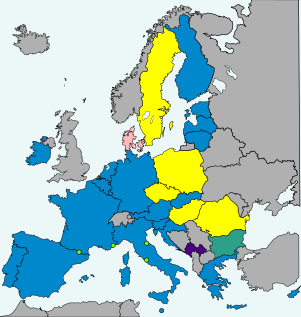
Back Lotyšské euromince Czech Lettiske euromønter Danish Lettische Euromünzen German Λετονικά κέρματα ευρώ Greek Latvaj eŭro-moneroj Esperanto Monedas de euro de Letonia Spanish Latvialaiset eurokolikot Finnish Pièces en euro de la Lettonie French Piéces en erô de la Lètonie FRP Lett euróérmék Hungarian

- European Union member states (special territories not shown)
- 20 in the eurozone1 in ERM II, with an opt-out (Denmark)5 not in ERM II, but obliged to join the eurozone on meeting the convergence criteria (Czech Republic, Hungary, Poland, Romania, and Sweden)
- Non–EU member states
Latvia replaced its previous currency, the lats, with the euro on 1 January 2014,[1] after a European Union (EU) assessment in June 2013 asserted that the country had met all convergence criteria necessary for euro adoption. The adoption process began 1 May 2004, when Latvia joined the European Union, entering the EU's Economic and Monetary Union. At the start of 2005, the lats was pegged to the euro at Ls 0.702804 = €1, and Latvia joined the European Exchange Rate Mechanism (ERM ll), four months later on 2 May 2005.[2]
- ^ "Latvia becomes the 18th Member State to adopt the euro". European Commission. 31 December 2013. Retrieved 31 December 2013.
- ^ "ECB: Euro central rates and compulsory intervention rates in ERM II". European Central Bank. 2 May 2005. Retrieved 1 January 2014.
© MMXXIII Rich X Search. We shall prevail. All rights reserved. Rich X Search